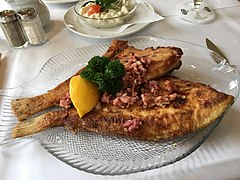Flounder fish)
| plaice | ||||||||||||
|---|---|---|---|---|---|---|---|---|---|---|---|---|

Plaice ( Pleuronectes platessa ) |
||||||||||||
| Systematics | ||||||||||||
|
||||||||||||
| Scientific name | ||||||||||||
| Pleuronectes platessa | ||||||||||||
| Linnaeus , 1758 |
The plaice or the goldbutt ( Pleuronectes platessa ) belongs to the order of the flatfish (Pleuronectiformes) as well as to the family of the plaice and is a food fish .
etymology
The High German name Scholle for fish, which was first verifiable in the 16th century , is seen as a borrowing from the Low German schulle, scholle , which can be traced back to the 14th century. This is compared to the more general term “ Scholle” for a flat piece of earth or ice , although the name is assumed to be transferred due to the external similarity. A connection with the Latin name solea for plaice is not excluded .
description
In the case of the plaice, the eyes move to the right side of the body during the metamorphosis , so that it does not belong to the family of the somewhat smaller butte , which are left-eyed. The side of the eye is gray-brown in color and speckled with characteristic circular reddish to yellowish dots (eponymous for the name goldbutt). The blind side below is whitish. The plaice is able to match the color of the pigmented side of the body on top to the ground to camouflage it , which is why the speckles are not always visible. In the event of danger, it burrows itself superficially into the sand by hitting the fin edges from the dorsal and anal fin . The two ends of the fin edge are not fused with the caudal fin .
Adult clods reach a body length of 40 to a maximum of 70 centimeters. They can live to be up to 45 years old and then weigh up to seven kilograms.
nutrition
The plaice feeds - mostly looking for food at night - on bristle worms , small crustaceans , thin-shelled mussels , snails and lugworms . She goes on long hikes.
Multiplication
Plaice spawn in the winter months, in our latitudes at around 6 degrees Celsius and a minimum salt content of 10 to 12 grams of salt per liter, for example in the southwestern North Sea. They give off between 50,000 and 500,000 eggs with a diameter of 1.6 to 2.1 millimeters that float freely in the water. From them, six millimeter long larvae hatch after 10 to 20 days. These initially have a bilaterally symmetrical shape and feed on plankton while swimming . Only after one to two months do they transform into an asymmetrical bottom fish; the left eye moves over to the right side of the body.
Male clods become sexually mature after three to four years with a length of 18 to 26 centimeters, while females only mature after six to nine years with a length of 30 to 40 centimeters.
distribution
Their occurrence extends over almost all European coasts: from the White Sea to the Portuguese Atlantic coast , but also in the North and western Baltic Sea , as well as in the western Mediterranean . The plaice lives in swarms over sand and silt bottom at depths of 100 to 200 meters, in the Mediterranean up to 400 meters.
use
The plaice is one of the economically most important edible fish . Around the world, 100,000 to 120,000 tons per year are caught mainly with the trawl . The late sexual maturity of the fish leads to constantly decreasing stocks under the condition of heavy fishing. In the past, clods of up to 50 years old and less than a meter long and weighing 7 kilograms were occasionally caught; today, however, the average catch size is 25 to 40 centimeters. This means that large parts of the plaice population are caught before they reach sexual maturity. In many places this leads to overfishing of the stocks. According to the Federal Research Institute for Fisheries , at the end of 2006 there were “at least 250,000 tons of plaice” in European sea areas.
The plaice caught in spring is known in the trade as corn plaice .
- Examples of its use as food fish
Hazardous situation and countermeasures
The IUCN, the International Union for Conservation of Nature, rates the plaice as not endangered ( Least Concern ).
The environmental organization WWF sees it the same way, but rates the trapping method with beam trawls as harmful to the seabed and the living organisms that have settled there.
Greenpeace classifies the consumption of plaice in its 2016 fish guide as “unacceptable”. This excludes plaice from the Northeast Pacific, Bering Sea, Gulf of Alaska fishing area and bottom longline fishing methods and anchor / snurrewaden.
Web links
- Plaice (fish) on Fishbase.org (English)
- Plaice in the fish lexicon of the fish processing company Deutsche See
Individual evidence
- ↑ Article 'Scholle' in the Etymological Dictionary of the DWDS (after Pfeifer)
- ↑ Schiller, Karl: Middle Low German Dictionary by Karl Schiller and August Lübben. Bremen: Kühtmann [u. a.]. Vol. 4 (1878), p. 148.
- ↑ Kluge. Etymological dictionary of the German language. Edited by Elmar Seebold. 25th, revised and expanded edition. Berlin / New York: De Gruyter 2011, p. 824.
- ↑ Press release of the Senate of the Federal Research Centers in the BMELV division of December 22, 2006 1:44 p.m.
- ^ IUCN Red List of Threatened Species. Retrieved March 11, 2019 .
- ↑ Fish shopping guide. WWF Germany, accessed March 11, 2019 .
- ↑ Fischratgeber 2016. (PDf) Greenpeace Germany, accessed on March 11, 2019 .



